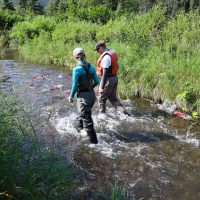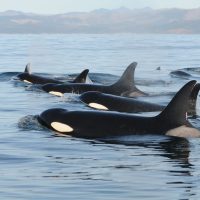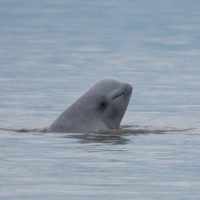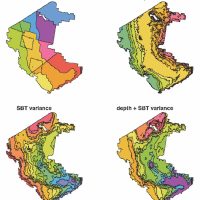Filter Results
Integrating mathematics with fishery science: another year of the Varanasi Internship
Now running for over a decade, the Varanasi Quantitative Undergraduate Summer Internship Program brings together math and fisheries sciences in a unique experience for students, who spend a summer working on research projects at NOAA Northwest Fisheries Science Center (NWFSC).
A collaborative program jointly funded by NOAA Fisheries, SAFS and the UW Department of Mathematics, and endowed by Usha and S.
Celebrating diversity in STEM and winning student awards at SACNAS 2023
The National Diversity in Stem Conference (NDiSTEM) organized by the Society for Advancement of Chicanos/Hispanics & Native Americans in Science (SACNAS) is the largest multidisciplinary and multicultural STEM diversity event in the U.S., serving to equip, empower, and energize participants for their academic and professional paths in STEM.
At the 2023 event held in October in Portland, SAFS graduate student, Nicole Doran, won the research presentation prize for Best Graduate Student Oral Presentation in the field of Ecology and Evolution, and recent Marine Biology graduate, Olivia Anderson, won a Native American/Indigenous Student Research Abstract Award.
Witnessing one of nature’s most impressive migrations: a summer with the Alaska Salmon Program
Nestled among a set of glacial lakes in the Wood River system is where scientists with the Alaska Salmon Program spend their summers. From students just beginning their research journeys in aquatic sciences, to seasoned field technicians and faculty, the camps based on Lake Aleknagik and Lake Nerka are the temporary home for both scientists and the fish that they are studying: Pacific salmon.
Read moreThe scientists watching their life’s work disappear: Kristin Laidre featured in the NY Times
The Arctic is warming much faster than the rest of the planet. I study animals that are inextricably tied to the sea ice, which is disappearing. Narwhals spend most of their time in deep water, in and under dense ice. They need cold water. The other species I study is polar bears. Everything about being a polar bear is tied to the ice.
Read moreLooking to the past to inform the future
Historical ecology and data-limited fisheries stock assessment methods shed light on threatened Puget Sound Yelloweye Rockfish
By applying elements of historical ecology, fisheries science, and conservation biology in a highly collaborative research effort, researchers from the University of Washington School of Aquatic and Fishery Sciences (SAFS), NOAA Fisheries, and the Washington Department of Fish and Wildlife (WDFW) are delivering new insights into the status of Yelloweye Rockfish.
Open lab position for a Research Scientist/Engineer II with SAFS and NOAA
The University of Washington Whale and Dolphin Ecology lab and the Genetics and Evolution lab at NOAA Northwest Fisheries Science Center are seeking to hire a Research Scientist/Engineer II – Molecular Genetics Technician to support projects assessing marine mammal and fish population genetics using a wide variety of genetic lab techniques. The position will primarily support the genetic analysis of killer whale diets using fecal samples, with additional opportunities to work on various fish and marine mammal genetics projects expected.
Read moreWhy are some protected species failing to recover?
New study uses integrated population models to predict extinction risk for Cook Inlet beluga whales and lend insight into factors limiting the recovery of protected populations.
Sparse monitoring data and persistent knowledge gaps can hamper conservation efforts aimed at recovering depleted wildlife populations. In a new study, researchers from the UW School of Aquatic and Fishery Sciences (SAFS) set out to tackle this issue for federally endangered Cook Inlet beluga whales by developing an integrated population model that capitalizes on all available information to understand factors that may be affecting survival, reproduction, and population viability.
Bird backpacks: GPS tagging of rhinoceros auklets and pigeon guillemots on Protection Island
In an effort to establish a better understanding of the foraging habits of rhinoceros auklets and pigeon guillemots on Protection Island, Liam Pendleton’s seabird research has involved GPS tagging and monitoring of these seabird species to delineate key foraging locations in the waters surrounding the island. Rhinoceros auklets migrate all along the West Coast of the US and Canada, and nest on the same island as pigeon guillemots, featured in a previous article by SAFS.
Read moreAdapting monitoring to a changing seascape: efficiency, flexibility and continuity for bottom trawl surveys
Fishery-independent survey data represents essential information for stock assessment, ecosystem-based fishery management initiatives, and applied ecological research. These data refers to information collected over space and time about populations of marine organisms, such as population abundance and biomass. The data can be used to fit statistical models to obtain multiple products for the assessment and management of marine populations. and can provide a comprehensive and standardized picture of marine populations when collected consistently over time, particularly with respect to gear selectivity and sampling design.
Read moreDirector’s Message: Autumn 2023
So two coastal ecologists and a quantitative environmental scientist walk into a bar ….
Nope, not a joke! It is just the School’s newest faculty getting together for a social hour. That’s right, this past academic year we successfully recruited three outstanding new faculty to our School. This newsletter edition includes a feature on Corey Garza, who arrived in September and is already building up his lab.









